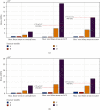Effect of Calcar Screw in Locking Compression Plate System for Osteoporotic Proximal Humerus Fracture: A Finite Element Analysis Study
- PMID: 36158892
- PMCID: PMC9499776
- DOI: 10.1155/2022/1268774
Effect of Calcar Screw in Locking Compression Plate System for Osteoporotic Proximal Humerus Fracture: A Finite Element Analysis Study
Abstract
This study proposes a finite element analysis (FEA) model for complex fractures at the osteoporotic proximal humerus and investigates the relevance of using a calcar screw in surgical treatments using this model. Two types of three-dimensional (3D) fracture models of patients with osteoporotic humerus were constructed reflecting the mechanical properties of the osteoporotic humerus, such as the Young's modulus and Poisson's ratio, and two load conditions mimicking the clinical environment were applied for simulation. Using the 3D models and the conditions, the FEA software calculated the concentration and distribution of stresses developing in the humerus, locking compression plate (LCP), and screws. Then, we evaluated and predicted the fixed state of a LCP system depending on whether the maximum stress value exceeded tensile strength. When axial force was applied, insertion of the calcar screw led to significant reduction of stress applied on screws in the fracture model having a medial gap by approximately 61%, from 913.20 MPa to 351.84 MPa. Based on the results, it was clearly confirmed that using of calcar screws improved the stability of a three-part fractures and simultaneously reinforced medial support.
Copyright © 2022 Jung-Soo Lee et al.
Conflict of interest statement
The authors declare that they have no conflicts of interest.
Figures




References
-
- Oh J. H., Kim Y. H. The current concepts in the treatment of proximal humerus fracture. Journal of the Korean Fracture Society . 2012;25(1):p. 94. doi: 10.12671/jkfs.2012.25.1.94. - DOI
-
- Liao C., Wang P., Xie Y., Fan T., Li P., Liang W. Different surgical methods for treatment of senile osteoporotic comminuted proximal humerus fracture. Zhongguo Xiu Fu Chong Jian Wai Ke Za Zhi. . 2009;23(12):1443–1446. - PubMed
MeSH terms
LinkOut - more resources
Full Text Sources
Medical
Miscellaneous

